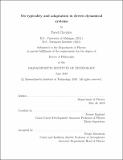| dc.contributor.advisor | Jeremy England. | en_US |
| dc.contributor.author | Chvykov, Pavel. | en_US |
| dc.contributor.other | Massachusetts Institute of Technology. Department of Physics. | en_US |
| dc.date.accessioned | 2020-01-08T19:31:30Z | |
| dc.date.available | 2020-01-08T19:31:30Z | |
| dc.date.copyright | 2019 | en_US |
| dc.date.issued | 2019 | en_US |
| dc.identifier.uri | https://hdl.handle.net/1721.1/123349 | |
| dc.description | This electronic version was submitted by the student author. The certified thesis is available in the Institute Archives and Special Collections. | en_US |
| dc.description | Thesis: Ph. D., Massachusetts Institute of Technology, Department of Physics, 2019 | en_US |
| dc.description | Cataloged from student-submitted PDF version of thesis. | en_US |
| dc.description | Includes bibliographical references (pages 125-130). | en_US |
| dc.description.abstract | In this work, I consider the possibility of using typicality-type arguments for understanding intractably complex damped-driven dynamical systems. By approximating such dynamics with appropriately constrained random process, I illustrate quantitative predictive power for some aspects of the motion. In particular, I argue that local dynamical stability, or exit rate, of a state is typically sufficient to predict steady-state probability in such systems -- circumventing the classic no-go theorems via our disorder approximation. I then focus on one consequence of this result: that the most likely long-time configurations should also be the dynamically stable ones. In a strongly-driven system, however, such stability may be hard to achieve, and therefore has interesting implications about the corresponding configurations: they must be well-adapted to the details of the driving forces, their dynamical robustness may be viewed in the context of self-healing, and depending on the drive, they can require substantial collective fine-tuning among the system's degrees of freedom. I confirm the emergence of such adapted states in several example systems, both in simulation and in experiment, and verify a quantitative agreement with the predicted scaling between their steady-state probability and local stability. I then explore several arguments and test-cases suggesting further generality of this framework. While it is not yet clear what the precise limits of applicability are for this approach, our results suggest that the intuition it builds can help with prediction and design in a broad class of complex dynamics. | en_US |
| dc.description.statementofresponsibility | by Pavel Chvykov. | en_US |
| dc.format.extent | 130 pages | en_US |
| dc.language.iso | eng | en_US |
| dc.publisher | Massachusetts Institute of Technology | en_US |
| dc.rights | MIT theses are protected by copyright. They may be viewed, downloaded, or printed from this source but further reproduction or distribution in any format is prohibited without written permission. | en_US |
| dc.rights.uri | http://dspace.mit.edu/handle/1721.1/7582 | en_US |
| dc.subject | Physics. | en_US |
| dc.title | On typicality and adaptation in driven dynamical systems | en_US |
| dc.type | Thesis | en_US |
| dc.description.degree | Ph. D. | en_US |
| dc.contributor.department | Massachusetts Institute of Technology. Department of Physics | en_US |
| dc.identifier.oclc | 1132797178 | en_US |
| dc.description.collection | Ph.D. Massachusetts Institute of Technology, Department of Physics | en_US |
| dspace.imported | 2020-01-08T19:31:29Z | en_US |
| mit.thesis.degree | Doctoral | en_US |
| mit.thesis.department | Phys | en_US |
